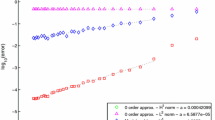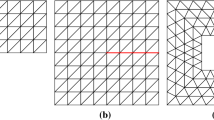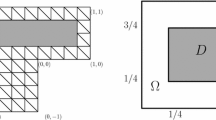Abstract
We consider the Poisson equation with Dirichlet boundary conditions, in a domain Ω\\(\bar B\), where Ω⊂ ℝn, and B is a collection of smooth open subsets (typically balls). The objective is to split the initial problem into two parts: a problem set in the whole domain Ω, for which fast solvers can be used, and local subproblems set in narrow domains around the connected components of B, which can be solved in a fully parallel way. We shall present here a method based on a multi-domain formulation of the initial problem, which leads to a fixed point algorithm. The convergence of the algorithm is established, under some conditions on a relaxation parameter θ. The dependence of the convergence interval for θ upon the geometry is investigated. Some 2D computations based on a finite element discretization of both global and local problems are presented.
Similar content being viewed by others
REFERENCES
Dautray, R., and Lions, J. L. (1990). Mathematical Analysis and Numerical Methods for Science and Technology, Vol. 1, Springer.
Girault, V., and Glowinski, R. (1995). Error analysis of a fictitious domain method applied to a Dirichlet problem. Japan J.Indust.Appl.Math. 12, 487–514.
Glowinski, R., and Kuznetsov, Y. (1998). On the solution of the Dirichlet problem for linear elliptic operators by a distributed Lagrange multiplier method. C.R.Acad.Sci.Paris Sér.I Math. 327, 693–698.
Glowinski, R., Pan, T.-W., Hesla, T. I., and Joseph, D. D. (1999). A distributed Lagrange Multiplier/fictitious domain method for particulate flows. Int.J.Multiphase Flow 25, 755.
McKenney, A., Greengard, L., and Mayo, A. (1995). A fast Poisson solver for complex geometries. J.Comput.Phys. 118, 348–355.
Heikkola, E., Kuznetsov, Yu., and Lipnikov, K. (1998). Fictitious domain methods for the numerical solution of 3D acoustic scattering problems. J.Comp.Acoustics 7, 161–183.
Heikkola, E., Rossi, T., and Toivanen, J. (2000). A Parallel Ficitious Domain Method for the Three-Dimensional Helmoltz Equation, Reports of the Department of Mathematical Information Technology, University of Jyväskylä, Series B. Scientific Computing, No. B9.
Le Tallec, P., and Tidriri, M. D. (1999). Convergence analysis of domain decomposition algorithms with full overlapping for the advection-diffusion problem. Math.Comp. 68, 585–606.
Leveque, R. J., and Li, Z. (1997). Immersed interface methods for Stokes flow with elastic boundaries or surface tension. SIAM J.Sci.Comput. 18, 709–735.
Maury, B. (1999). Direct simulation of 2D fluid particle flows in biperiodic domains. J.Comput.Phys. 156, 325–351.
Peskin, C. S., and McQueen, D. M. (1989). A three-dimensional computational method for blood flow in the heart I. Immersed elastic fibers in a viscous incompressible fluid. J.Comput.Phys. 81, 372–405.
Author information
Authors and Affiliations
Rights and permissions
About this article
Cite this article
Maury, B. A Fat Boundary Method for the Poisson Problem in a Domain with Holes. Journal of Scientific Computing 16, 319–339 (2001). https://doi.org/10.1023/A:1012821728631
Issue Date:
DOI: https://doi.org/10.1023/A:1012821728631




